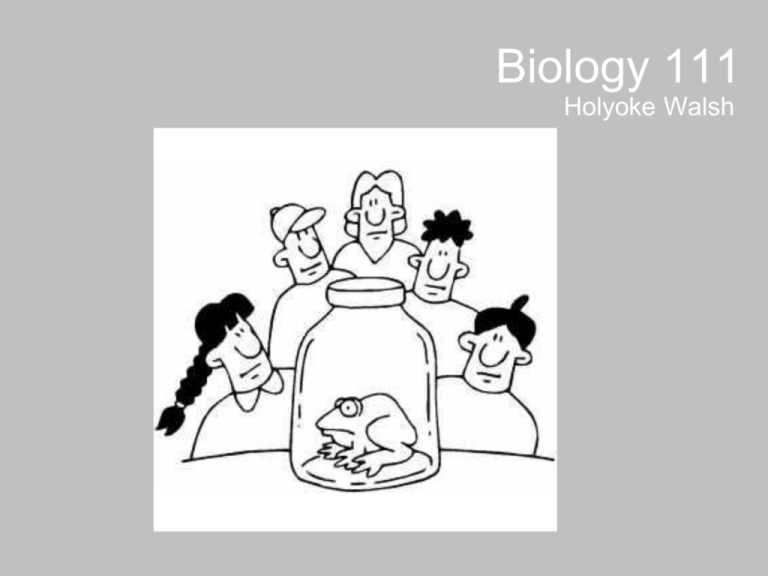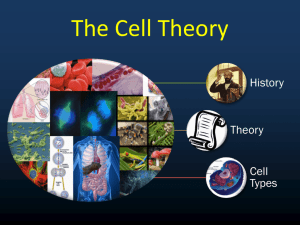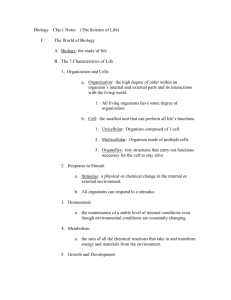
Biology 111
Holyoke Walsh
What is Science???
Science
Copyright 2008 PresentationFx.com | Redistribution Prohibited | Image © 2008 clix@sxc.hu | This text
section may be deleted for presentation.
The Goals of Science
1. Deals only
with the
Natural World
The
supernatural
is outside
the realm of
science
The Goals of Science
2. Collect & Organize Data
Goals of Science
3. Propose Explanations that can be tested
In Summary…..
• SCIENCE is a BODY of KNOWLEDGE
that EXPLAINS the NATURAL World.
Science Begins with Observation – How are
your Skills?
OBSERVATION
1. Quantitative – a quantity/number or
measure
2. Qualitative – a quality/characteristic;
description
Inference
• A logical interpretation based on prior
knowledge
• Examples of Inferences?
• What can be the problem with inferences?
• http://www.youtube.com/watch?v=tiy1MeX
zhfA
Hypothesis
• A proposed explanation; must be
TESTABLE; written in an “If….then” format
1. If I give my dog Purina dog food for a
month, then he will not shed as much.
2. If I use miracle grow then my plants
will produce more tomatoes.
3. If I use the drug Avapro for a week
then my blood pressure will be lower
Narrowing in on Science
• BIOLOGY – One Branch of Science
• Study of LIVING things
A Few Branches of Biology:
– Zoologists
– Botanists
– Paleontologists
– Cell Biologists
– Geneticists
– Microbiologists
– Ecologists
Copyright Pearson Prentice Hall
Biology is very broad (Remember it is
the study of LIVING things…and there are LOTS of
living things!!!!!)
Terminology rich; very
descriptive and has it’s own
language~
– Handout #1 – Give it a try
1-2 How Scientists Work
Scientists make educated guesses about
how things work the way they do. These are
called HYPOTHESIS.
How do scientists test hypotheses?
A hypothesis should be tested by an
experiment in which only one variable is
changed at a time.
Copyright Pearson Prentice Hall
Scientific Method
1)
2)
3)
4)
•
Ask questions, make observations
Gather information
Form a hypothesis (If…then)
Set up a controlled experiment
Manipulated variable - the variable
that is deliberately changed (aka
independent variable)
Responding variable is variable that is
observed (aka dependent variable)
5)Record and analyze results
6)Draw a conclusion
7)Repeat & share findings
Copyright 2008 PresentationFx.com | Redistribution Prohibited | Image © 2008 clix@sxc.hu | This text
section may be deleted for presentation.
Scientific Method Practice
Jordan is doing a science fair project on how music effects the
growth of tomatoes. He has two tomato plants, Plant A and Plant
B, that he grows in a window and gives the same amount of
water. Plant A is exposed to classical music using headphones
attached to the soil and plant B is not. Throughout the growth
period, Jordan counts the number of tomatoes produced by each
plant.
Plant A = 35 Tomatoes | Plant B = 55 Tomatoes
1) What is the control group?
2) What is the manipulated variable?
3) What is the responding variable?
4) What should Jordan’s conclusion be
5) Jordan needs to repeat the experiment, but his teacher says
that he needs to improve his design. In his second experiment,
Scientific Method Practice
In the same science fair, Tina asks the question “Does
caffeine increase the heart rate of an earthworm?” In Test
1, she measures the heart rate by looking at the earthworm
under a microscopes, the earthworm has a heart rate of 50
bpm (beats per minute). In Test 2, she places a few drops
of caffeine on the earthworm’s skin and measures the rate
again. In this test, the heart rate is 68 bpm.
6) What is the manipulated variable in this experiment?
7) What is the responding variable in this experiment?
8) Tina’s experiment should have included a hypothesis.
Using proper format, suggest a hypothesis for Tina’s
experiment.
SpongeBob HWK
Fill & Chill:
8 Characteristics of Living Things:
Textbook 1-3 (page 15-17)
1) Life is Cellular- smallest unit of life
unicellular = single celled (bacteria)
multicellular = many cells (human)
2. REPRODUCTION: Organisms
Reproduce to Pass on their Genetic
Traits
Two Types of Reproduction
• Sexual
Reproduction
•
•
•
Involves 2 parents
Egg (n) fertilized
by sperm (n) to
make a zygote
(2n)
Offspring
DIFFERENT from
parents
22
Two Types of Reproduction
• Asexual
Reproduction
•
•
•
Involves a single
organism or cell
(2n)
Cell divides
Offspring
IDENTICAL to
parent (2n)
23
3. Cells Have a Genetic Code
(DNA/RNA)
copyright cmassengale
24
• DNA (deoxyribose nucleic acid)
carries the genetic code for all
organisms
• All organisms contain DNA
• DNA codes for the proteins that
make up cells & do all the work
25
4. Organisms Grow &
Develop
26
4. Growth & Development
• Organisms grow by
producing MORE
CELLS & by cell
ENLARGEMENT
• Organisms develop as
they mature into an
adult organism
27
5. Cells Require Food & Energy
28
Food Requirements
• Autotrophs can make
their own food
• Photoautotrophs use
sunlight to make food
(photosynthesis) – ex?
• Chemoautotrophs use
chemicals such as iron
& sulfur as their
energy – ex?
29
Food Requirements
Types of Heterotrophs: (cannot make own food)
• Holozoic nutrition: Complex food is taken into a
specialist digestive system and broken down into small
pieces to be absorbed. This consists of 5 stages,
ingestion, digestion, absorption, assimilation and
elimination. ….includes
herbivores/carnivores/omnivores
• Saprozoic/Saprobes: Organisms feed on dead organic
remains of other organisms.
• Parasitism: Organisms obtain food from other living
organisms (the host), with the host receiving no
benefit from the parasite.
• Mutualism: A symbiotic relationship between
organisms, with each contributing and benefiting from
each other.
30
Metabolism
• Sum of all the chemical reactions
in an organism
• All require energy
• Sunlight is the ultimate energy
for life on Earth
31
Metabolism
• Cellular Respiration
– Cells releasing the chemical
energy stored in foods
6O2 + C6H12O6
6CO2 + 6H2O
32
6. Organisms Respond to
Stimuli
• Organisms Respond to stimuli
(Temperature, Water, Food
Supplies, etc.) In Order To
Survive & Reproduce
33
7. Homeostasis
• Keeping The Internal Environment of
The Cell or Organism Within a
balance necessary for life
• Often called “equilibrium”
• Stable internal conditions of pH,
temperature, water balance, etc.
34
8. Living Things Evolve
• Groups Of
Organisms (Not
Individuals) Change
Over Time In Order
To Survive Changing
Environments.
• Fossil records show
changes in groups of
organisms
HWK
• Read sections 1-3/1-4 in Chapter 1
• Complete Chapter 1 Review
Biological Equipment
• What is the most common tool used by
biologists???
Leeuwenhoek
• Father of Microbiology…made many
improvements in microscopy
• made a simple microscope (mid 1600’s)
• magnified 270X
• Early microscope lenses made images larger
MODERN MICROSCOPES
• A microscope is simple or compound depending on
how many lenses it contains
• A lens makes an enlarged image & directs light
towards you eye
• A simple microscope has one lens
• Similar to a magnifying glass
• Magnification is the change in
apparent size produced by a
microscope
COMPOUND MICROSCOPE
• A compound microscope
has multiple lenses
– (ocular & objective lenses)
Do You Know The Parts?
•
•
•
•
•
http://www.biologycorner.com/microquiz/#
(handout #5)
Do you know how to focus a scope??
Make a dry/wet mount??
Put it away properly??
STEREOMICROSCOPE
aka: dissecting microscope
• creates a 3D
image
TOTAL MAGNIFICATION
• Powers of the eyepiece (10X) multiplied by
objective lenses determine total magnification.
ELECTRON MICROSCOPES
• More powerful; some can
magnify up to 1,000,000X
• Use a magnetic field in a
vacuum to bend beams of
electrons
• Images must be
photographed or
produced electronically
Scanning Electron Microscope (SEM)
Electron microscope image of a spider
• produces realistic 3D image
• only the surface of
specimen can be observed
Electron microscope image of a fly foot
SEM cont…
Guess?
Guess??
Guess??
Guess??
Transmission Electron Microscope (TEM)
• produces 2D image of
thinly sliced specimen
• detailed cell parts (only
inside a cell) can be
observed
Time for Biological Drawings
• See handout #6






